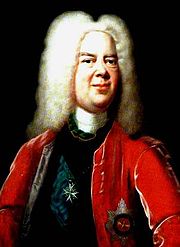
Louis Rudolph, Duke of Brunswick-Lüneburg
Encyclopedia

Brunswick-Lüneburg
The Duchy of Brunswick-Lüneburg , or more properly Duchy of Brunswick and Lüneburg, was an historical ducal state from the late Middle Ages until the late Early Modern era within the North-Western domains of the Holy Roman Empire of the German Nation, in what is now northern Germany...
(German: Ludwig Rudolf) (22 July 1671 – 1 March 1735) ruled over the Wolfenbüttel subdivision of the duchy from 1731 until his death.
Louis Rudolph was the youngest son of Anthony Ulrich, Duke of Brunswick-Lüneburg. He became a major general
Major General
Major general or major-general is a military rank used in many countries. It is derived from the older rank of sergeant major general. A major general is a high-ranking officer, normally subordinate to the rank of lieutenant general and senior to the ranks of brigadier and brigadier general...
in the service of Leopold I, Holy Roman Emperor
Leopold I, Holy Roman Emperor
| style="float:right;" | Leopold I was a Holy Roman Emperor, King of Hungary and King of Bohemia. A member of the Habsburg family, he was the second son of Emperor Ferdinand III and his first wife, Maria Anna of Spain. His maternal grandparents were Philip III of Spain and Margaret of Austria...
in 1690 and was promptly captured in battle by France
France
The French Republic , The French Republic , The French Republic , (commonly known as France , is a unitary semi-presidential republic in Western Europe with several overseas territories and islands located on other continents and in the Indian, Pacific, and Atlantic oceans. Metropolitan France...
. After being released the same year, his father gave him the County of Blankenburg
County of Blankenburg
The County of Blankenburg was a state of the Holy Roman Empire. Its capital was Blankenburg, it was located in and near the Harz mountains.-County of Blankenburg:...
as a present, thus violating primogeniture
Primogeniture
Primogeniture is the right, by law or custom, of the firstborn to inherit the entire estate, to the exclusion of younger siblings . Historically, the term implied male primogeniture, to the exclusion of females...
.
In 1707, Blankenburg was raised to a principality of the Holy Roman Empire
Holy Roman Empire
The Holy Roman Empire was a realm that existed from 962 to 1806 in Central Europe.It was ruled by the Holy Roman Emperor. Its character changed during the Middle Ages and the Early Modern period, when the power of the emperor gradually weakened in favour of the princes...
; in this way, Louis Rudolph became a ruling prince before his elder brother, Augustus William
Augustus William, Duke of Brunswick-Lüneburg
Augustus William, Duke of Brunswick-Lüneburg ruled over the Wolfenbüttel subdivision of the duchy from 1714 until his death....
.
On the death of Augustus William in 1731, Louis Rudolph also inherited Wolfenbüttel. After Augustus William had almost ruined the state, Louis Rudolph managed to restore the finances.
Louis Rudolph died without male issue in 1735. He was succeeded by his first cousin, Ferdinand Albert II, who had married Louis Rudolph's youngest daughter, Antoinette Amalie.
Family
Louis Rudolph married Christine LouisePrincess Christine Louise of Oettingen-Oettingen
Christine Louise of Oettingen-Oettingen was Duchess of Brunswick-Lüneburg and the maternal grandmother of Empress Maria Theresa, Queen Elisabeth Christine of Prussia, Queen Juliane Marie of Denmark and Tsar Peter II of Russia...
, daughter of Albert Ernest I, Prince of Oettingen
Öttingen-Öttingen
Oettingen-Oettingen was a noble family and county in modern-day eastern Baden-Württemberg and western Bavaria, Germany.Oettingen-Oettingen was created as a partition of Oettingen in 1423, became extinct in 1731 and was inherited by Oettingen-Wallerstein....
, at Aurich
Aurich
Aurich is a town in Lower Saxony, Germany. It is the capital of the district of Aurich.-History:The history of Aurich dates back to the 13th century, when the settlement of Aurechove was mentioned in a Frisian document called the Brokmerbrief in 1276. In 1517, Count Edzard from the house of...
in 1690. They had the following children who reached adulthood:
- Elisabeth Christine of Brunswick-WolfenbüttelElisabeth Christine of Brunswick-WolfenbüttelElisabeth Christine of Brunswick-Wolfenbüttel was Princess of Brunswick-Wolfenbüttel, Holy Roman Empress, German Queen, Queen of Bohemia and Hungary; and Archduchess of Austria by her marriage to Emperor Charles VI. She was renowned for her delicate beauty and also for being the mother of Empress...
(1691–1750), married Emperor Charles VI of AustriaCharles VI, Holy Roman EmperorCharles VI was the penultimate Habsburg sovereign of the Habsburg Empire. He succeeded his elder brother, Joseph I, as Holy Roman Emperor, King of Bohemia , Hungary and Croatia , Archduke of Austria, etc., in 1711... - Charlotte Christine of Brunswick-LüneburgCharlotte Christine of Brunswick-LüneburgCharlotte Christine Sophie also known as Sophie Charlotte or simply Charlotte , was the wife of Tsarevich Alexei Petrovich of Russia. She was the daughter of Louis Rudolph, Duke of Brunswick-Lüneburg and Christine Louise of Oettingen-Oettingen...
(1694–1715), married Tsarevich Alexei Petrovich of RussiaTsarevich Alexei Petrovich of RussiaAlexei Petrovich Romanov , was a Russian Tsarevich. He was born in Moscow, the son of Tsar Peter I and his first wife Eudoxia Lopukhina.-Childhood:...
, Peter the Great's son and heirHeir apparentAn heir apparent or heiress apparent is a person who is first in line of succession and cannot be displaced from inheriting, except by a change in the rules of succession.... - Antoinette Amalie of Brunswick-Wolfenbüttel (14 April 1696–6 March 1762), married Duke Ferdinand Albert II of Brunswick-Lüneburg

